Paper Menu >>
Journal Menu >>
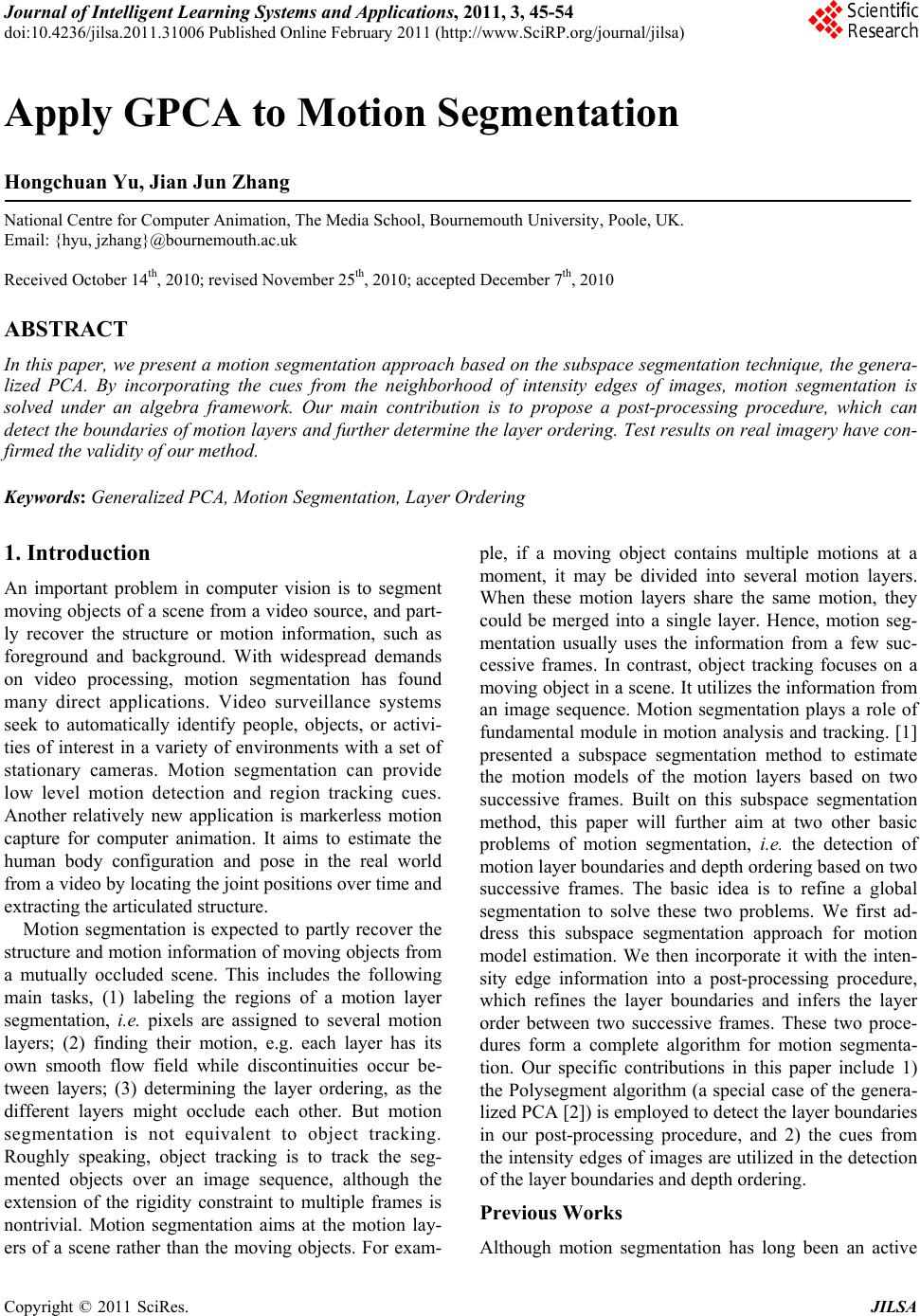 Journal of Intelligent Learning Systems and Applications, 2011, 3, 45-54 doi:10.4236/jilsa.2011.31006 Published Online February 2011 (http://www.SciRP.org/journal/jilsa) Copyright © 2011 SciRes. JILSA 45 Apply GPCA to Motion Segmentation Hongchuan Yu, Jian Jun Zhang National Centre for Computer Animation, The Media School, Bournemouth University, Poole, UK. Email: {hyu, jzhang}@bournemouth.ac.uk Received October 14th, 2010; revised November 25th, 2010; accepted December 7th, 2010 ABSTRACT In this paper, we present a motion segmentation approach based on the subspace segmentation technique, the genera- lized PCA. By incorporating the cues from the neighborhood of intensity edges of images, motion segmentation is solved under an algebra framework. Our main contribution is to propose a post-processing procedure, which can detect the boundaries of motion layers and further determine the layer ordering. Test results on real imagery have con- firmed the validity of our method. Keywords: Ge ner al i zed PCA , Motion Segme nt ati o n, Layer Ordering 1. Introduction An important problem in computer vision is to segment moving objects of a scene from a video source, and part- ly recover the structure or motion information, such as foreground and background. With widespread demands on video processing, motion segmentation has found many direct applications. Video surveillance systems seek to automatically identify people, objects, or activi- ties of interest in a variety of environments with a set of stationary cameras. Motion segmentation can provide low level motion detection and region tracking cues. Another relatively new application is markerless motion capture for computer animation. It aims to estimate the human body configuration and pose in the real world from a video by locating the joint positions over time and extracting the articulated structure. Motion segmentation is expected to partly recover the structure and motion information of moving objects from a mutually occluded scene. This includes the following main tasks, (1) labeling the regions of a motion layer segmentation, i.e. pixels are assigned to several motion layers; (2) finding their motion, e.g. each layer has its own smooth flow field while discontinuities occur be- tween layers; (3) determining the layer ordering, as the different layers might occlude each other. But motion segmentation is not equivalent to object tracking. Roughly speaking, object tracking is to track the seg- mented objects over an image sequence, although the extension of the rigidity constraint to multiple frames is nontrivial. Motion segmentation aims at the motion lay- ers of a scene rather than the moving objects. For exam- ple, if a moving object contains multiple motions at a moment, it may be divided into several motion layers. When these motion layers share the same motion, they could be merged into a single layer. Hence, motion seg- mentation usually uses the information from a few suc- cessive frames. In contrast, object tracking focuses on a moving object in a scene. It utilizes the information from an image sequence. Motion segmentation plays a role of fundamental module in motion analysis and tracking. [1] presented a subspace segmentation method to estimate the motion models of the motion layers based on two successive frames. Built on this subspace segmentation method, this paper will further aim at two other basic problems of motion segmentation, i.e. the detection of motion layer boundaries and depth ordering based on two successive frames. The basic idea is to refine a global segmentation to solve these two problems. We first ad- dress this subspace segmentation approach for motion model estimation. We then incorporate it with the inten- sity edge information into a post-processing procedure, which refines the layer boundaries and infers the layer order between two successive frames. These two proce- dures form a complete algorithm for motion segmenta- tion. Our specific contributions in this paper include 1) the Polysegment algorithm (a special case of the genera- lized PCA [2]) is employed to detect the layer boundaries in our post-processing procedure, and 2) the cues from the intensity edges of images are utilized in the detection of the layer boundaries and depth ordering. Previous Works Although motion segmentation has long been an active 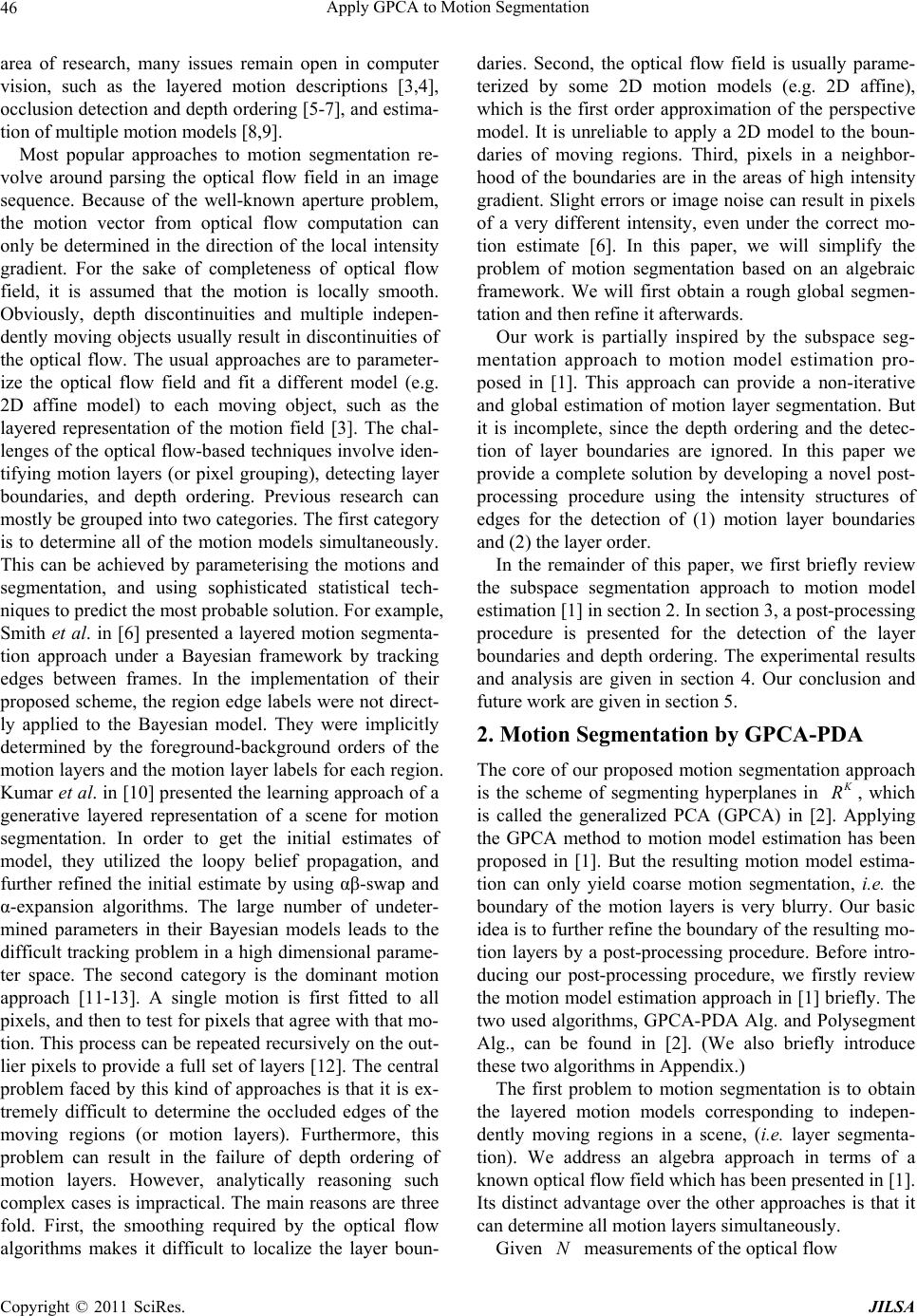 Apply GPCA to Motion Segmentation Copyright © 2011 SciRes. JILSA 46 area of research, many issues remain open in computer vision, such as the layered motion descriptions [3,4], occlusion detection and depth ordering [5-7], and estima- tion of multiple motion models [8,9]. Most popular approaches to motion segmentation re- volve around parsing the optical flow field in an image sequence. Because of the well-known aperture problem, the motion vector from optical flow computation can only be determined in the direction of the local intensity gradient. For the sake of completeness of optical flow field, it is assumed that the motion is locally smooth. Obviously, depth discontinuities and multiple indepen- dently moving objects usually result in discontinuities of the optical flow. The usual approaches are to parameter- ize the optical flow field and fit a different model (e.g. 2D affine model) to each moving object, such as the layered representation of the motion field [3]. The chal- lenges of the optical flow-based techniques involve iden- tifying motion layers (or pixel grouping), detecting layer boundaries, and depth ordering. Previous research can mostly be grouped into two categories. The first category is to determine all of the motion models simultaneously. This can be achieved by parameterising the motions and segmentation, and using sophisticated statistical tech- niques to predict the most probable solution. For example, Smith et al. in [6] presented a layered motion segmenta- tion approach under a Bayesian framework by tracking edges between frames. In the implementation of their proposed scheme, the region edge labels were not direct- ly applied to the Bayesian model. They were implicitly determined by the foreground-background orders of the motion layers and the motion layer labels for each region. Kumar et al. in [10] presented the learning approach of a generative layered representation of a scene for motion segmentation. In order to get the initial estimates of model, they utilized the loopy belief propagation, and further refined the initial estimate by using αβ-swap and α-expansion algorithms. The large number of undeter- mined parameters in their Bayesian models leads to the difficult tracking problem in a high dimensional parame- ter space. The second category is the dominant motion approach [11-13]. A single motion is first fitted to all pixels, and then to test for pixels that agree with that mo- tion. This process can be repeated recursively on the out- lier pixels to provide a full set of layers [12]. The central problem faced by this kind of approaches is that it is ex- tremely difficult to determine the occluded edges of the moving regions (or motion layers). Furthermore, this problem can result in the failure of depth ordering of motion layers. However, analytically reasoning such complex cases is impractical. The main reasons are three fold. First, the smoothing required by the optical flow algorithms makes it difficult to localize the layer boun- daries. Second, the optical flow field is usually parame- terized by some 2D motion models (e.g. 2D affine), which is the first order approximation of the perspective model. It is unreliable to apply a 2D model to the boun- daries of moving regions. Third, pixels in a neighbor- hood of the boundaries are in the areas of high intensity gradient. Slight errors or image noise can result in pixels of a very different intensity, even under the correct mo- tion estimate [6]. In this paper, we will simplify the problem of motion segmentation based on an algebraic framework. We will first obtain a rough global segmen- tation and then refine it afterwards. Our work is partially inspired by the subspace seg- mentation approach to motion model estimation pro- posed in [1]. This approach can provide a non-iterative and global estimation of motion layer segmentation. But it is incomplete, since the depth ordering and the detec- tion of layer boundaries are ignored. In this paper we provide a complete solution by developing a novel post- processing procedure using the intensity structures of edges for the detection of (1) motion layer boundaries and (2) the layer order. In the remainder of this paper, we first briefly review the subspace segmentation approach to motion model estimation [1] in section 2. In section 3, a post-processing procedure is presented for the detection of the layer boundaries and depth ordering. The experimental results and analysis are given in section 4. Our conclusion and future work are given in section 5. 2. Motion Segmentation by GPCA-PDA The core of our proposed motion segmentation approach is the scheme of segmenting hyperplanes in K R, which is called the generalized PCA (GPCA) in [2]. Applying the GPCA method to motion model estimation has been proposed in [1]. But the resulting motion model estima- tion can only yield coarse motion segmentation, i.e. the boundary of the motion layers is very blurry. Our basic idea is to further refine the boundary of the resulting mo- tion layers by a post-processing procedure. Before intro- ducing our post-processing procedure, we firstly review the motion model estimation approach in [1] briefly. The two used algorithms, GPCA-PDA Alg. and Polysegment Alg., can be found in [2]. (We also briefly introduce these two algorithms in Appendix.) The first problem to motion segmentation is to obtain the layered motion models corresponding to indepen- dently moving regions in a scene, (i.e. layer segmenta- tion). We address an algebra approach in terms of a known optical flow field which has been presented in [1]. Its distinct advantage over the other approaches is that it can determine all motion layers simultaneously. Given N measurements of the optical flow 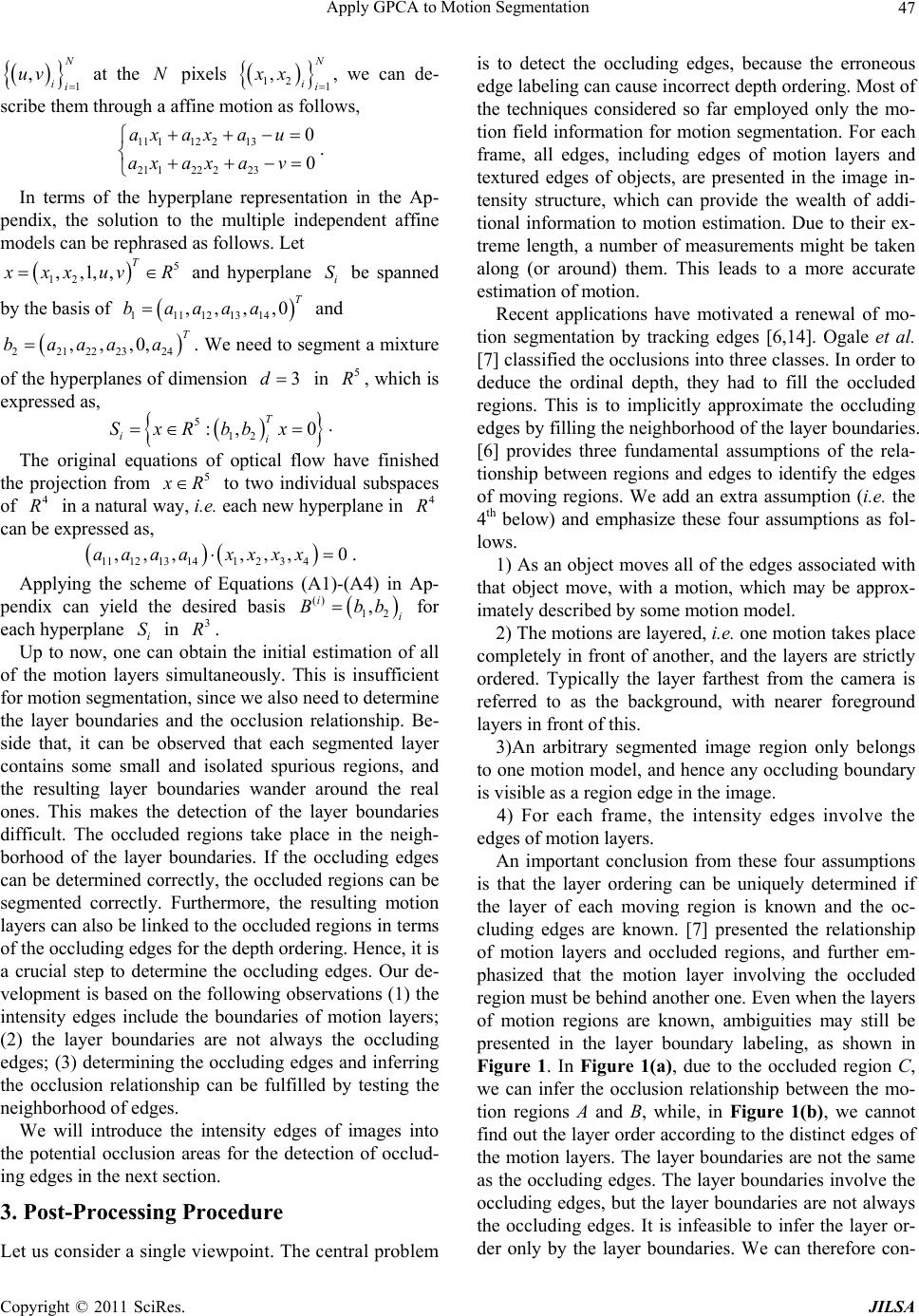 Apply GPCA to Motion Segmentation Copyright © 2011 SciRes. JILSA 47 1 , N ii uv at the N pixels 12 1 , N ii xx , we can de- scribe them through a affine motion as follows, 11 112213 21 122223 0 0 ax axau ax axav . In terms of the hyperplane representation in the Ap- pendix, the solution to the multiple independent affine models can be rephrased as follows. Let 5 12 ,,1,,T x xx uvR and hyperplane i S be spanned by the basis of 111121314 ,,,,0 T baaaa and 221222324 ,,,0, T baaaa. We need to segment a mixture of the hyperplanes of dimension 3d in 5 R, which is expressed as, 5 12 :, 0 T ii SxRbbx . The original equations of optical flow have finished the projection from 5 x R to two individual subspaces of 4 R in a natural way, i.e. each new hyperplane in 4 R can be expressed as, 11 1213141234 ,,,,,, 0aaaa xxxx. Applying the scheme of Equations (A1)-(A4) in Ap- pendix can yield the desired basis () 12 , i i Bbb for each hyperplane i S in 3 R. Up to now, one can obtain the initial estimation of all of the motion layers simultaneously. This is insufficient for motion segmentation, since we also need to determine the layer boundaries and the occlusion relationship. Be- side that, it can be observed that each segmented layer contains some small and isolated spurious regions, and the resulting layer boundaries wander around the real ones. This makes the detection of the layer boundaries difficult. The occluded regions take place in the neigh- borhood of the layer boundaries. If the occluding edges can be determined correctly, the occluded regions can be segmented correctly. Furthermore, the resulting motion layers can also be linked to the occluded regions in terms of the occluding edges for the depth ordering. Hence, it is a crucial step to determine the occluding edges. Our de- velopment is based on the following observations (1) the intensity edges include the boundaries of motion layers; (2) the layer boundaries are not always the occluding edges; (3) determining the occluding edges and inferring the occlusion relationship can be fulfilled by testing the neighborhood of edges. We will introduce the intensity edges of images into the potential occlusion areas for the detection of occlud- ing edges in the next section. 3. Post-Processing Procedure Let us consider a single viewpoint. The central problem is to detect the occluding edges, because the erroneous edge labeling can cause incorrect depth ordering. Most of the techniques considered so far employed only the mo- tion field information for motion segmentation. For each frame, all edges, including edges of motion layers and textured edges of objects, are presented in the image in- tensity structure, which can provide the wealth of addi- tional information to motion estimation. Due to their ex- treme length, a number of measurements might be taken along (or around) them. This leads to a more accurate estimation of motion. Recent applications have motivated a renewal of mo- tion segmentation by tracking edges [6,14]. Ogale et al. [7] classified the occlusions into three classes. In order to deduce the ordinal depth, they had to fill the occluded regions. This is to implicitly approximate the occluding edges by filling the neighborhood of the layer boundaries. [6] provides three fundamental assumptions of the rela- tionship between regions and edges to identify the edges of moving regions. We add an extra assumption (i.e. the 4th below) and emphasize these four assumptions as fol- lows. 1) As an object moves all of the edges associated with that object move, with a motion, which may be approx- imately described by some motion model. 2) The motions are layered, i.e. one motion takes place completely in front of another, and the layers are strictly ordered. Typically the layer farthest from the camera is referred to as the background, with nearer foreground layers in front of this. 3)An arbitrary segmented image region only belongs to one motion model, and hence any occluding boundary is visible as a region edge in the image. 4) For each frame, the intensity edges involve the edges of motion layers. An important conclusion from these four assumptions is that the layer ordering can be uniquely determined if the layer of each moving region is known and the oc- cluding edges are known. [7] presented the relationship of motion layers and occluded regions, and further em- phasized that the motion layer involving the occluded region must be behind another one. Even when the layers of motion regions are known, ambiguities may still be presented in the layer boundary labeling, as shown in Figure 1. In Figure 1(a), due to the occluded region C, we can infer the occlusion relationship between the mo- tion regions A and B, while, in Figure 1(b), we cannot find out the layer order according to the distinct edges of the motion layers. The layer boundaries are not the same as the occluding edges. The layer boundaries involve the occluding edges, but the layer boundaries are not always the occluding edges. It is infeasible to infer the layer or- der only by the layer boundaries. We can therefore con- 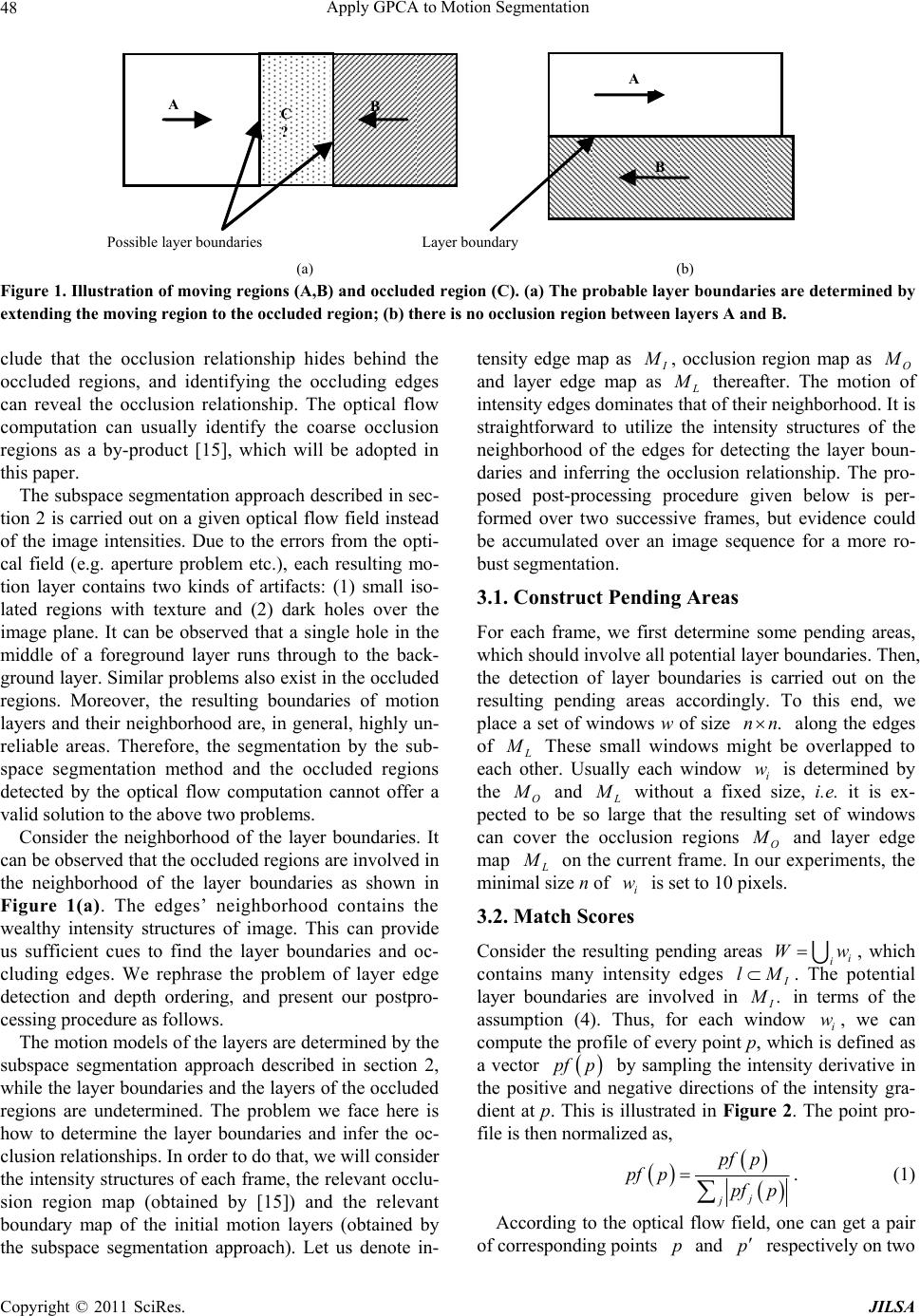 Apply GPCA to Motion Segmentation Copyright © 2011 SciRes. JILSA 48 (a) (b) Figure 1. Illustration of moving re gions (A,B) and occluded regi on (C). (a) The probable layer boundar ies are determined by extending the moving region to the occluded region; (b) ther e is no occlusion r e g ion be tween layers A and B. clude that the occlusion relationship hides behind the occluded regions, and identifying the occluding edges can reveal the occlusion relationship. The optical flow computation can usually identify the coarse occlusion regions as a by-product [15], which will be adopted in this paper. The subspace segmentation approach described in sec- tion 2 is carried out on a given optical flow field instead of the image intensities. Due to the errors from the opti- cal field (e.g. aperture problem etc.), each resulting mo- tion layer contains two kinds of artifacts: (1) small iso- lated regions with texture and (2) dark holes over the image plane. It can be observed that a single hole in the middle of a foreground layer runs through to the back- ground layer. Similar problems also exist in the occluded regions. Moreover, the resulting boundaries of motion layers and their neighborhood are, in general, highly un- reliable areas. Therefore, the segmentation by the sub- space segmentation method and the occluded regions detected by the optical flow computation cannot offer a valid solution to the above two problems. Consider the neighborhood of the layer boundaries. It can be observed that the occluded regions are involved in the neighborhood of the layer boundaries as shown in Figure 1(a). The edges’ neighborhood contains the wealthy intensity structures of image. This can provide us sufficient cues to find the layer boundaries and oc- cluding edges. We rephrase the problem of layer edge detection and depth ordering, and present our postpro- cessing procedure as follows. The motion models of the layers are determined by the subspace segmentation approach described in section 2, while the layer boundaries and the layers of the occluded regions are undetermined. The problem we face here is how to determine the layer boundaries and infer the oc- clusion relationships. In order to do that, we will consider the intensity structures of each frame, the relevant occlu- sion region map (obtained by [15]) and the relevant boundary map of the initial motion layers (obtained by the subspace segmentation approach). Let us denote in- tensity edge map as I M , occlusion region map as O M and layer edge map as L M thereafter. The motion of intensity edges dominates that of their neighborhood. It is straightforward to utilize the intensity structures of the neighborhood of the edges for detecting the layer boun- daries and inferring the occlusion relationship. The pro- posed post-processing procedure given below is per- formed over two successive frames, but evidence could be accumulated over an image sequence for a more ro- bust segmentation. 3.1. Construct Pending Areas For each frame, we first determine some pending areas, which should involve all potential layer boundaries. Then, the detection of layer boundaries is carried out on the resulting pending areas accordingly. To this end, we place a set of windows w of size .nn along the edges of L M These small windows might be overlapped to each other. Usually each window i w is determined by the O M and L M without a fixed size, i.e. it is ex- pected to be so large that the resulting set of windows can cover the occlusion regions O M and layer edge map L M on the current frame. In our experiments, the minimal size n of i w is set to 10 pixels. 3.2. Match Scores Consider the resulting pending areas i i Ww, which contains many intensity edges I lM. The potential layer boundaries are involved in . I M in terms of the assumption (4). Thus, for each window i w, we can compute the profile of every point p, which is defined as a vector pfp by sampling the intensity derivative in the positive and negative directions of the intensity gra- dient at p. This is illustrated in Figure 2. The point pro- file is then normalized as, j j pf p pf ppf p . (1) According to the optical flow field, one can get a pair of corresponding points p and p respectively on two A A B B C ? Possible layer boundaries Layer boundary 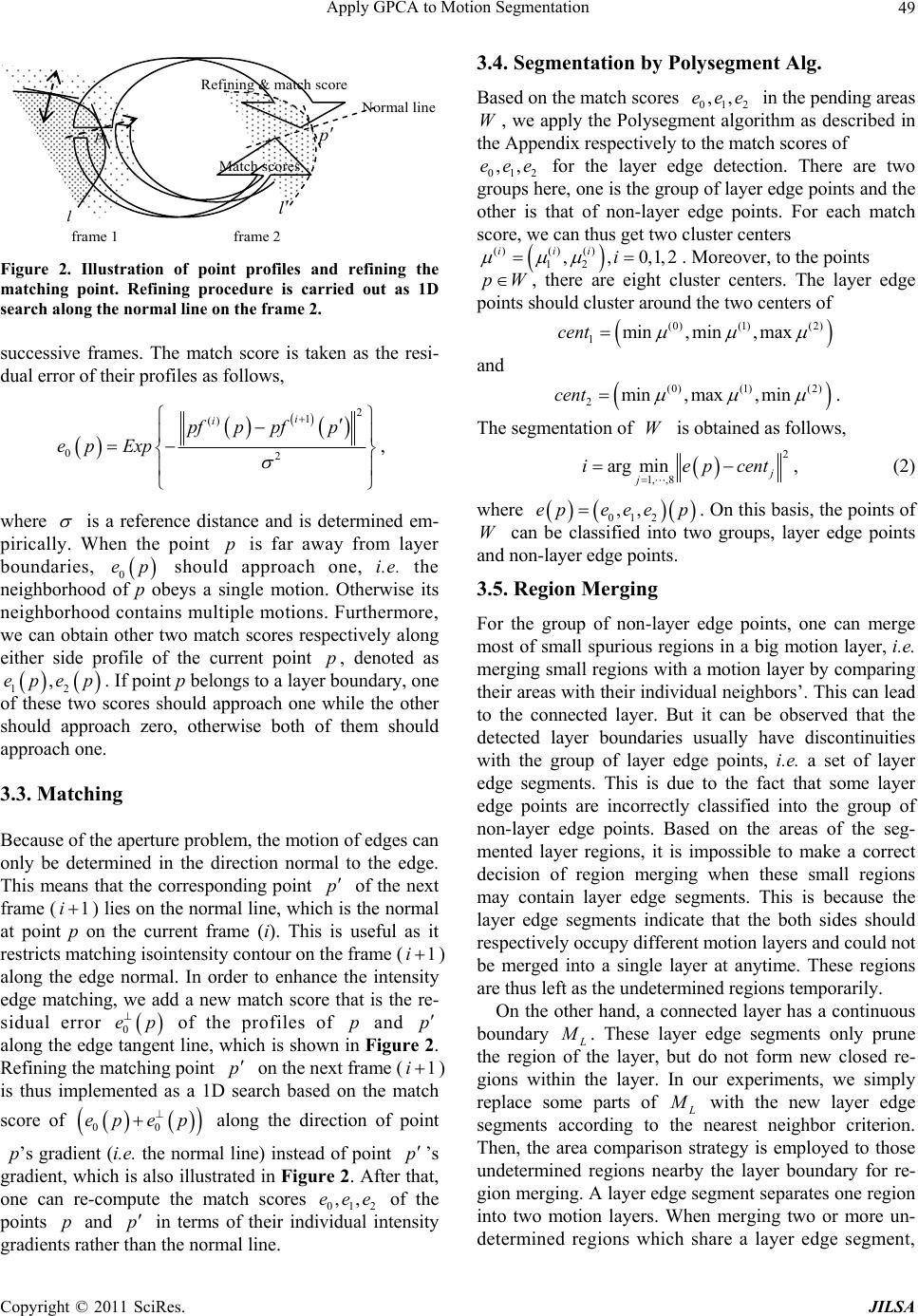 Apply GPCA to Motion Segmentation Copyright © 2011 SciRes. JILSA 49 l frame 1 frame 2 p l Normal line Refining & match score Match scores p Figure 2. Illustration of point profiles and refining the matching point. Refining procedure is carried out as 1D search along the normal line on the frame 2. successive frames. The match score is taken as the resi- dual error of their profiles as follows, 2 1 () 02 i i pfp pfp ep Exp , where is a reference distance and is determined em- pirically. When the point p is far away from layer boundaries, 0 ep should approach one, i.e. the neighborhood of p obeys a single motion. Otherwise its neighborhood contains multiple motions. Furthermore, we can obtain other two match scores respectively along either side profile of the current point p, denoted as 12 ,epep . If point p belongs to a layer boundary, one of these two scores should approach one while the other should approach zero, otherwise both of them should approach one. 3.3. Matching Because of the aperture problem, the motion of edges can only be determined in the direction normal to the edge. This means that the corresponding point p of the next frame (1i) lies on the normal line, which is the normal at point p on the current frame (i). This is useful as it restricts matching isointensity contour on the frame (1i ) along the edge normal. In order to enhance the intensity edge matching, we add a new match score that is the re- sidual error 0 ep of the profiles of p and p along the edge tangent line, which is shown in Figure 2. Refining the matching point p on the next frame (1i ) is thus implemented as a 1D search based on the match score of 00 epe p along the direction of point p’s gradient (i.e. the normal line) instead of point p ’s gradient, which is also illustrated in Figure 2. After that, one can re-compute the match scores 012 ,,eee of the points p and p in terms of their individual intensity gradients rather than the normal line. 3.4. Segmentation by Polysegment Alg. Based on the match scores 012 ,,eee in the pending areas W, we apply the Polysegment algorithm as described in the Appendix respectively to the match scores of 012 ,,eee for the layer edge detection. There are two groups here, one is the group of layer edge points and the other is that of non-layer edge points. For each match score, we can thus get two cluster centers ()() () 12 ,,0,1,2 iii i . Moreover, to the points pW , there are eight cluster centers. The layer edge points should cluster around the two centers of (0) (1)(2) 1min,min, maxcent and (0)(1) (2) 2min,max, mincent . The segmentation of W is obtained as follows, 2 1, ,8 arg minj j ie pcent , (2) where 012 ,,epeee p. On this basis, the points of W can be classified into two groups, layer edge points and non-layer edge points. 3.5. Region Merging For the group of non-layer edge points, one can merge most of small spurious regions in a big motion layer, i.e. merging small regions with a motion layer by comparing their areas with their individual neighbors’. This can lead to the connected layer. But it can be observed that the detected layer boundaries usually have discontinuities with the group of layer edge points, i.e. a set of layer edge segments. This is due to the fact that some layer edge points are incorrectly classified into the group of non-layer edge points. Based on the areas of the seg- mented layer regions, it is impossible to make a correct decision of region merging when these small regions may contain layer edge segments. This is because the layer edge segments indicate that the both sides should respectively occupy different motion layers and could not be merged into a single layer at anytime. These regions are thus left as the undetermined regions temporarily. On the other hand, a connected layer has a continuous boundary L M . These layer edge segments only prune the region of the layer, but do not form new closed re- gions within the layer. In our experiments, we simply replace some parts of L M with the new layer edge segments according to the nearest neighbor criterion. Then, the area comparison strategy is employed to those undetermined regions nearby the layer boundary for re- gion merging. A layer edge segment separates one region into two motion layers. When merging two or more un- determined regions which share a layer edge segment, 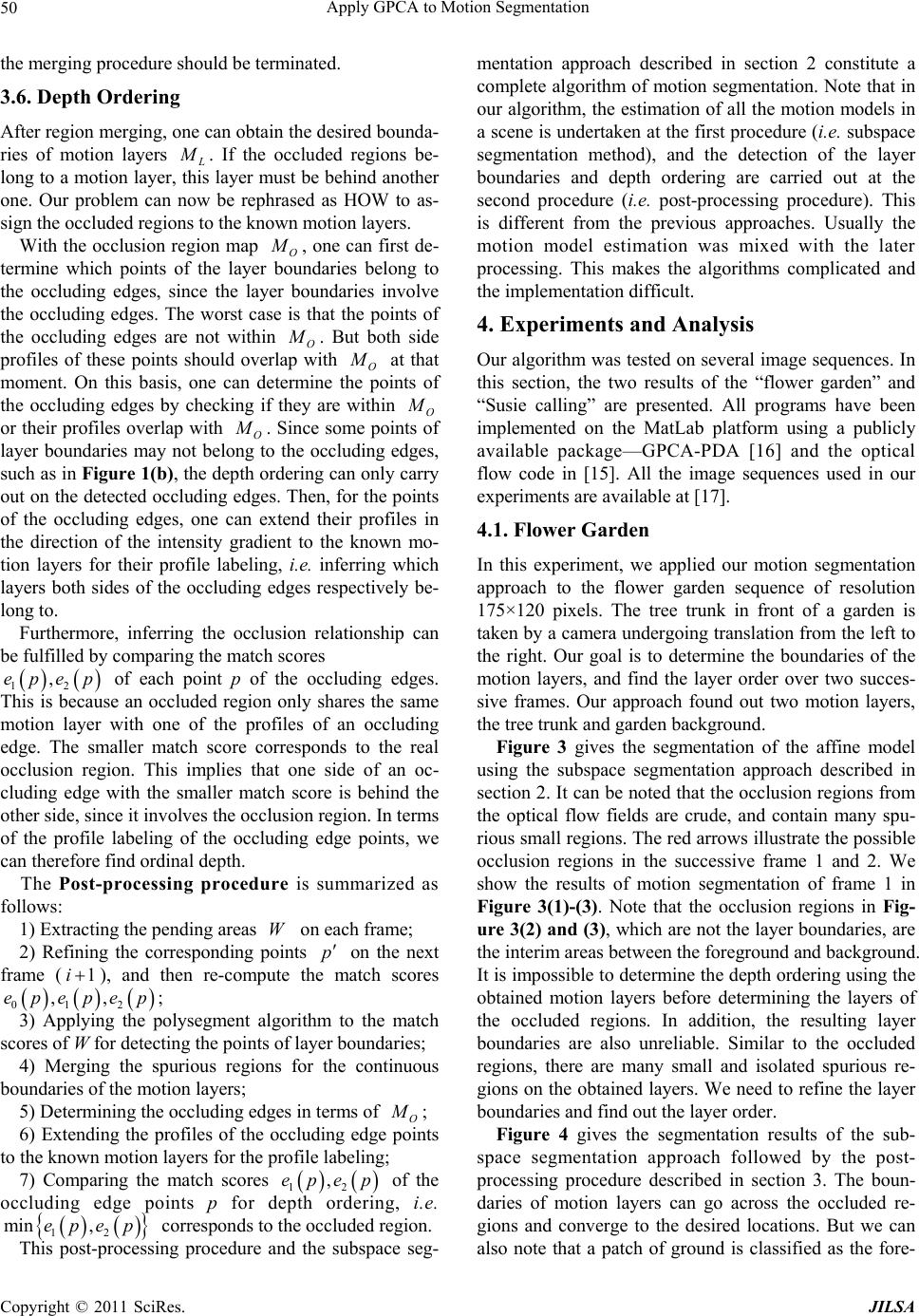 Apply GPCA to Motion Segmentation Copyright © 2011 SciRes. JILSA 50 the merging procedure should be terminated. 3.6. Depth Ordering After region merging, one can obtain the desired bounda- ries of motion layers L M . If the occluded regions be- long to a motion layer, this layer must be behind another one. Our problem can now be rephrased as HOW to as- sign the occluded regions to the known motion layers. With the occlusion region map O M , one can first de- termine which points of the layer boundaries belong to the occluding edges, since the layer boundaries involve the occluding edges. The worst case is that the points of the occluding edges are not within O M . But both side profiles of these points should overlap with O M at that moment. On this basis, one can determine the points of the occluding edges by checking if they are within O M or their profiles overlap with O M . Since some points of layer boundaries may not belong to the occluding edges, such as in Figure 1(b), the depth ordering can only carry out on the detected occluding edges. Then, for the points of the occluding edges, one can extend their profiles in the direction of the intensity gradient to the known mo- tion layers for their profile labeling, i.e. inferring which layers both sides of the occluding edges respectively be- long to. Furthermore, inferring the occlusion relationship can be fulfilled by comparing the match scores 12 ,epep of each point p of the occluding edges. This is because an occluded region only shares the same motion layer with one of the profiles of an occluding edge. The smaller match score corresponds to the real occlusion region. This implies that one side of an oc- cluding edge with the smaller match score is behind the other side, since it involves the occlusion region. In terms of the profile labeling of the occluding edge points, we can therefore find ordinal depth. The Post-processing procedure is summarized as follows: 1) Extracting the pending areas W on each frame; 2) Refining the corresponding points p on the next frame (1i), and then re-compute the match scores 012 ,,epepep; 3) Applying the polysegment algorithm to the match scores of W for detecting the points of layer boundaries; 4) Merging the spurious regions for the continuous boundaries of the motion layers; 5) Determining the occluding edges in terms of O M ; 6) Extending the profiles of the occluding edge points to the known motion layers for the profile labeling; 7) Comparing the match scores 12 ,epep of the occluding edge points p for depth ordering, i.e. 12 min ,epep corresponds to the occluded region. This post-processing procedure and the subspace seg- mentation approach described in section 2 constitute a complete algorithm of motion segmentation. Note that in our algorithm, the estimation of all the motion models in a scene is undertaken at the first procedure (i.e. subspace segmentation method), and the detection of the layer boundaries and depth ordering are carried out at the second procedure (i.e. post-processing procedure). This is different from the previous approaches. Usually the motion model estimation was mixed with the later processing. This makes the algorithms complicated and the implementation difficult. 4. Experiments and Analysis Our algorithm was tested on several image sequences. In this section, the two results of the “flower garden” and “Susie calling” are presented. All programs have been implemented on the MatLab platform using a publicly available package—GPCA-PDA [16] and the optical flow code in [15]. All the image sequences used in our experiments are available at [17]. 4.1. Flower Garden In this experiment, we applied our motion segmentation approach to the flower garden sequence of resolution 175×120 pixels. The tree trunk in front of a garden is taken by a camera undergoing translation from the left to the right. Our goal is to determine the boundaries of the motion layers, and find the layer order over two succes- sive frames. Our approach found out two motion layers, the tree trunk and garden background. Figure 3 gives the segmentation of the affine model using the subspace segmentation approach described in section 2. It can be noted that the occlusion regions from the optical flow fields are crude, and contain many spu- rious small regions. The red arrows illustrate the possible occlusion regions in the successive frame 1 and 2. We show the results of motion segmentation of frame 1 in Figure 3(1)-(3). Note that the occlusion regions in Fig- ure 3(2) and (3), which are not the layer boundaries, are the interim areas between the foreground and background. It is impossible to determine the depth ordering using the obtained motion layers before determining the layers of the occluded regions. In addition, the resulting layer boundaries are also unreliable. Similar to the occluded regions, there are many small and isolated spurious re- gions on the obtained layers. We need to refine the layer boundaries and find out the layer order. Figure 4 gives the segmentation results of the sub- space segmentation approach followed by the post- processing procedure described in section 3. The boun- daries of motion layers can go across the occluded re- gions and converge to the desired locations. But we can also note that a patch of ground is classified as the fore- 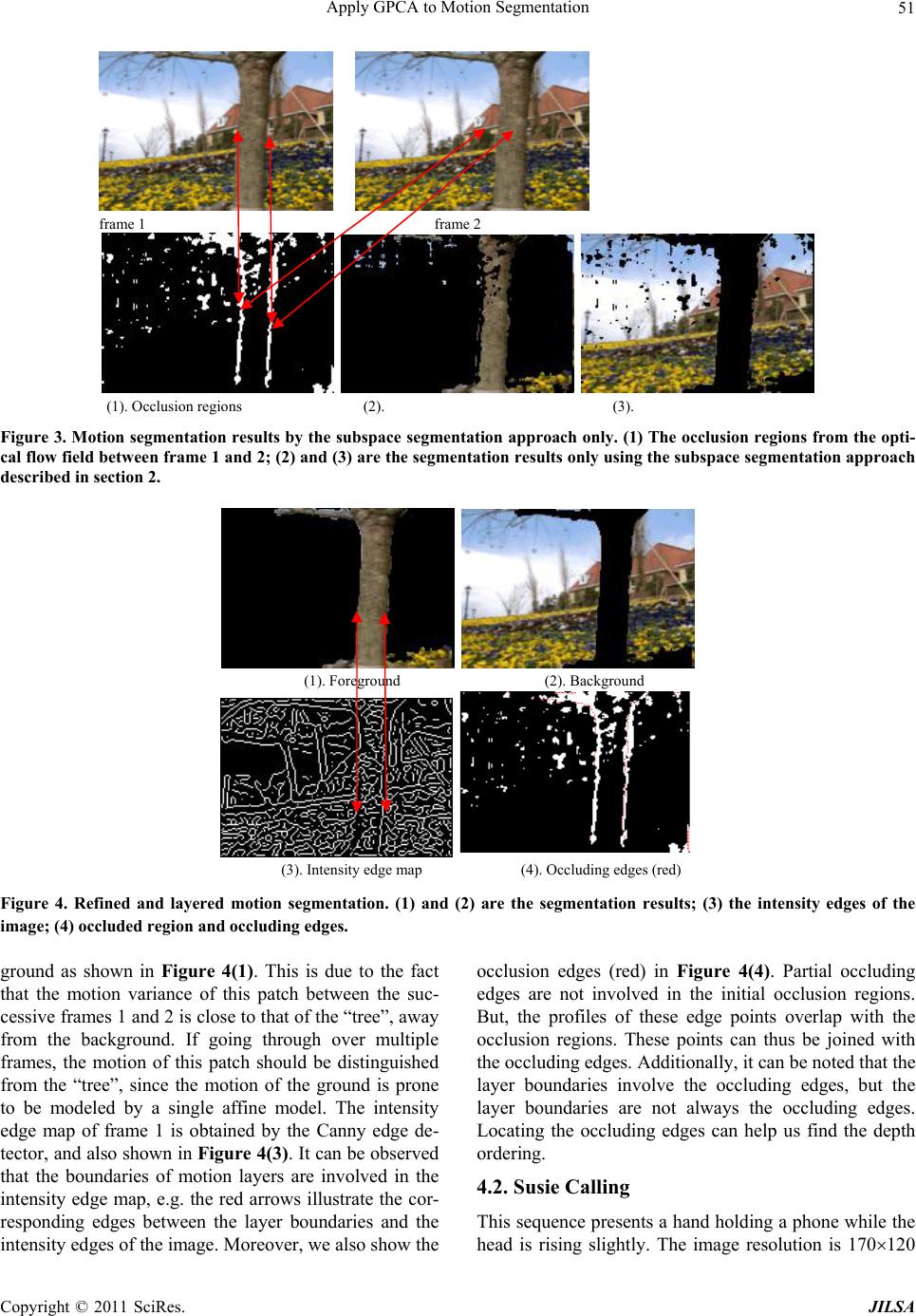 Apply GPCA to Motion Segmentation Copyright © 2011 SciRes. JILSA 51 frame 1 frame 2 (1). Occlusion regions (2). (3). Figure 3. Motion segmentation results by the subspace segmentation approach only. (1) The occlusion regions from the opti- cal flow field betw een frame 1 and 2; (2) and (3) are the segmentation results only using the subspace segmentation approach described in section 2. (1). Foreground (2). Background (3). Intensity edge map (4). Occluding edges (red) Figure 4. Refined and layered motion segmentation. (1) and (2) are the segmentation results; (3) the intensity edges of the image; (4) occluded region and occluding edges. ground as shown in Figure 4(1). This is due to the fact that the motion variance of this patch between the suc- cessive frames 1 and 2 is close to that of the “tree”, away from the background. If going through over multiple frames, the motion of this patch should be distinguished from the “tree”, since the motion of the ground is prone to be modeled by a single affine model. The intensity edge map of frame 1 is obtained by the Canny edge de- tector, and also shown in Figure 4(3). It can be observed that the boundaries of motion layers are involved in the intensity edge map, e.g. the red arrows illustrate the cor- responding edges between the layer boundaries and the intensity edges of the image. Moreover, we also show the occlusion edges (red) in Figure 4(4). Partial occluding edges are not involved in the initial occlusion regions. But, the profiles of these edge points overlap with the occlusion regions. These points can thus be joined with the occluding edges. Additionally, it can be noted that the layer boundaries involve the occluding edges, but the layer boundaries are not always the occluding edges. Locating the occluding edges can help us find the depth ordering. 4.2. Susie Calling This sequence presents a hand holding a phone while the head is rising slightly. The image resolution is 170120 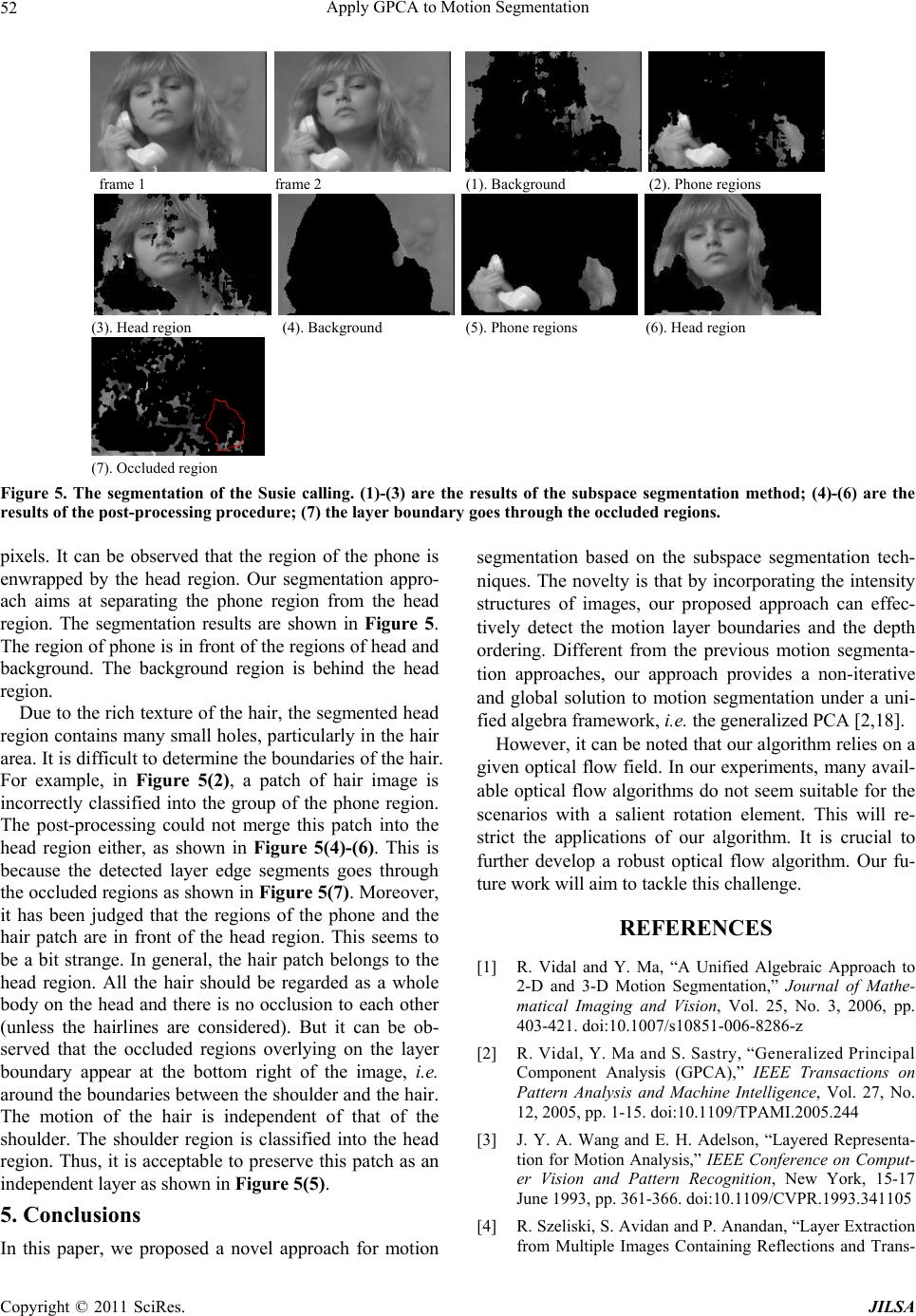 Apply GPCA to Motion Segmentation Copyright © 2011 SciRes. JILSA 52 frame 1 frame 2 (1). Background (2). Phone regions (3). Head region (4). Background (5). Phone regions (6). Head region (7). Occluded region Figure 5. The segmentation of the Susie calling. (1)-(3) are the results of the subspace segmentation method; (4)-(6) are the results of the post-processing proc e dur e; (7) the layer boundary goes thro ugh the occluded regions. pixels. It can be observed that the region of the phone is enwrapped by the head region. Our segmentation appro- ach aims at separating the phone region from the head region. The segmentation results are shown in Figure 5. The region of phone is in front of the regions of head and background. The background region is behind the head region. Due to the rich texture of the hair, the segmented head region contains many small holes, particularly in the hair area. It is difficult to determine the boundaries of the hair. For example, in Figure 5(2), a patch of hair image is incorrectly classified into the group of the phone region. The post-processing could not merge this patch into the head region either, as shown in Figure 5(4)-(6). This is because the detected layer edge segments goes through the occluded regions as shown in Figure 5(7). Moreover, it has been judged that the regions of the phone and the hair patch are in front of the head region. This seems to be a bit strange. In general, the hair patch belongs to the head region. All the hair should be regarded as a whole body on the head and there is no occlusion to each other (unless the hairlines are considered). But it can be ob- served that the occluded regions overlying on the layer boundary appear at the bottom right of the image, i.e. around the boundaries between the shoulder and the hair. The motion of the hair is independent of that of the shoulder. The shoulder region is classified into the head region. Thus, it is acceptable to preserve this patch as an independent layer as shown in Figure 5(5). 5. Conclusions In this paper, we proposed a novel approach for motion segmentation based on the subspace segmentation tech- niques. The novelty is that by incorporating the intensity structures of images, our proposed approach can effec- tively detect the motion layer boundaries and the depth ordering. Different from the previous motion segmenta- tion approaches, our approach provides a non-iterative and global solution to motion segmentation under a uni- fied algebra framework, i.e. the generalized PCA [2,18]. However, it can be noted that our algorithm relies on a given optical flow field. In our experiments, many avail- able optical flow algorithms do not seem suitable for the scenarios with a salient rotation element. This will re- strict the applications of our algorithm. It is crucial to further develop a robust optical flow algorithm. Our fu- ture work will aim to tackle this challenge. REFERENCES [1] R. Vidal and Y. Ma, “A Unified Algebraic Approach to 2-D and 3-D Motion Segmentation,” Journal of Mathe- matical Imaging and Vision, Vol. 25, No. 3, 2006, pp. 403-421. doi:10.1007/s10851-006-8286-z [2] R. Vidal, Y. Ma and S. Sastry, “Generalized Principal Component Analysis (GPCA),” IEEE Transactions on Pattern Analysis and Machine Intelligence, Vol. 27, No. 12, 2005, pp. 1-15. doi:10.1109/TPAMI.2005.244 [3] J. Y. A. Wang and E. H. Adelson, “Layered Representa- tion for Motion Analysis,” IEEE Conference on Comput- er Vision and Pattern Recognition, New York, 15-17 June 1993, pp. 361-366. doi:10.1109/CVPR.1993.341105 [4] R. Szeliski, S. Avidan and P. Anandan, “Layer Extraction from Multiple Images Containing Reflections and Trans- 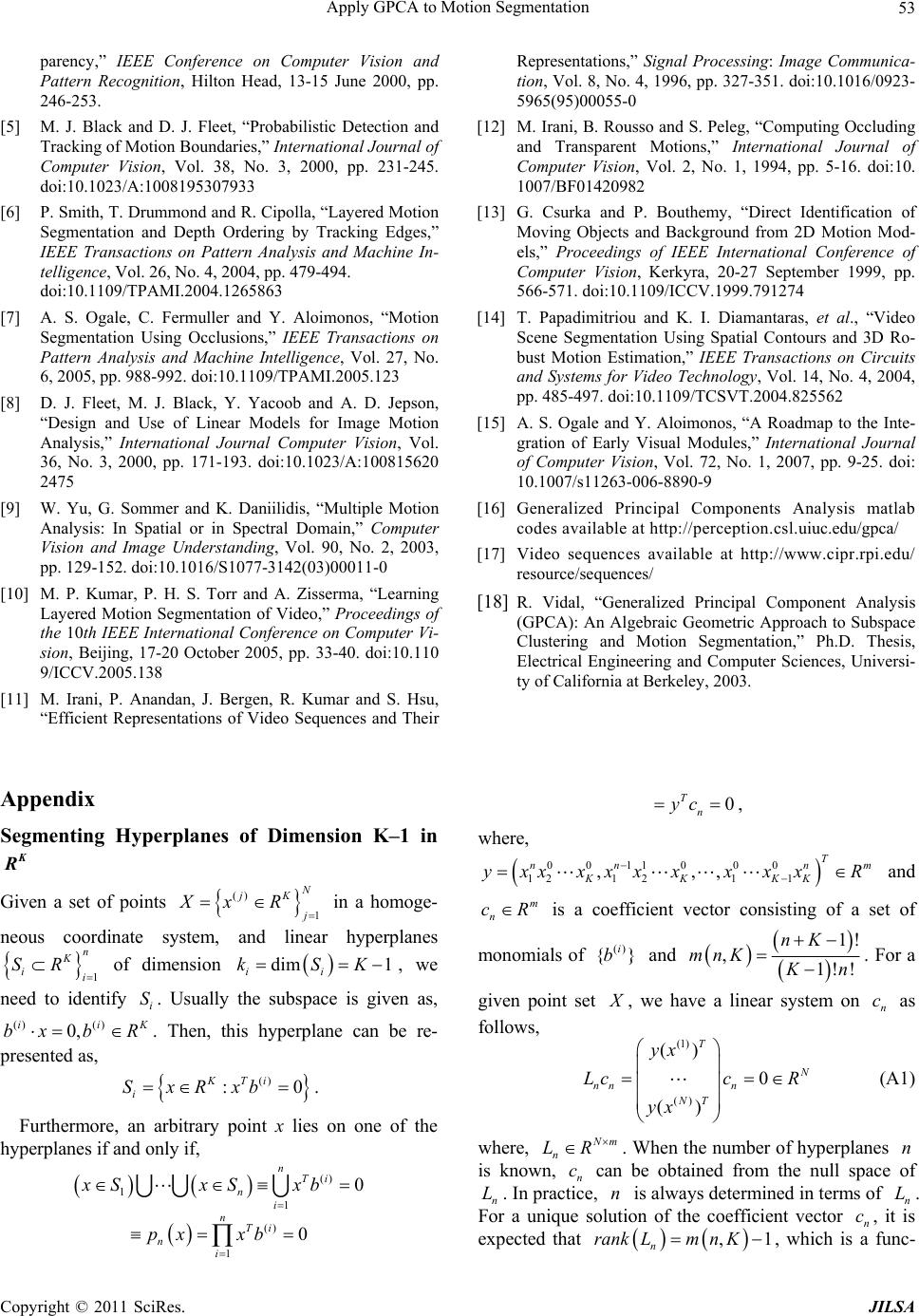 Apply GPCA to Motion Segmentation Copyright © 2011 SciRes. JILSA 53 parency,” IEEE Conference on Computer Vision and Pattern Recognition, Hilton Head, 13-15 June 2000, pp. 246-253. [5] M. J. Black and D. J. Fleet, “Probabilistic Detection and Tracking of Motion Boundaries,” International Journal of Computer Vision, Vol. 38, No. 3, 2000, pp. 231-245. doi:10.1023/A:1008195307933 [6] P. Smith, T. Drummond and R. Cipolla, “Layered Motion Segmentation and Depth Ordering by Tracking Edges,” IEEE Transactions on Pattern Analysis and Machine In- telligence, Vol. 26, No. 4, 2004, pp. 479-494. doi:10.1109/TPAMI.2004.1265863 [7] A. S. Ogale, C. Fermuller and Y. Aloimonos, “Motion Segmentation Using Occlusions,” IEEE Transactions on Pattern Analysis and Machine Intelligence, Vol. 27, No. 6, 2005, pp. 988-992. doi:10.1109/TPAMI.2005.123 [8] D. J. Fleet, M. J. Black, Y. Yacoob and A. D. Jepson, “Design and Use of Linear Models for Image Motion Analysis,” International Journal Computer Vision, Vol. 36, No. 3, 2000, pp. 171-193. doi:10.1023/A:100815620 2475 [9] W. Yu, G. Sommer and K. Daniilidis, “Multiple Motion Analysis: In Spatial or in Spectral Domain,” Computer Vision and Image Understanding, Vol. 90, No. 2, 2003, pp. 129-152. doi:10.1016/S1077-3142(03)00011-0 [10] M. P. Kumar, P. H. S. Torr and A. Zisserma, “Learning Layered Motion Segmentation of Video,” Proceedings of the 10th IEEE International Conference on Computer Vi- sion, Beijing, 17-20 October 2005, pp. 33-40. doi:10.110 9/ICCV.2005.138 [11] M. Irani, P. Anandan, J. Bergen, R. Kumar and S. Hsu, “Efficient Representations of Video Sequences and Their Representations,” Signal Processing: Image Communica- tion, Vol. 8, No. 4, 1996, pp. 327-351. doi:10.1016/0923- 5965(95)00055-0 [12] M. Irani, B. Rousso and S. Peleg, “Computing Occluding and Transparent Motions,” International Journal of Computer Vision, Vol. 2, No. 1, 1994, pp. 5-16. doi:10. 1007/BF01420982 [13] G. Csurka and P. Bouthemy, “Direct Identification of Moving Objects and Background from 2D Motion Mod- els,” Proceedings of IEEE International Conference of Computer Vision, Kerkyra, 20-27 September 1999, pp. 566-571. doi:10.1109/ICCV.1999.791274 [14] T. Papadimitriou and K. I. Diamantaras, et al., “Video Scene Segmentation Using Spatial Contours and 3D Ro- bust Motion Estimation,” IEEE Transactions on Circuits and Systems for Video Technology, Vol. 14, No. 4, 2004, pp. 485-497. doi:10.1109/TCSVT.2004.825562 [15] A. S. Ogale and Y. Aloimonos, “A Roadmap to the Inte- gration of Early Visual Modules,” International Journal of Computer Vision, Vol. 72, No. 1, 2007, pp. 9-25. doi: 10.1007/s11263-006-8890-9 [16] Generalized Principal Components Analysis matlab codes available at http://perception.csl.uiuc.edu/gpca/ [17] Video sequences available at http://www.cipr.rpi.edu/ resource/sequences/ [18] R. Vidal, “Generalized Principal Component Analysis (GPCA): An Algebraic Geometric Approach to Subspace Clustering and Motion Segmentation,” Ph.D. Thesis, Electrical Engineering and Computer Sciences, Universi- ty of California at Berkeley, 2003. Appendix Segmenting Hyperplanes of Dimension K–1 in K R Given a set of points () 1 N jK j Xx R in a homoge- neous coordinate system, and linear hyperplanes 1 n K ii SR of dimension dim 1 ii kSK, we need to identify i S. Usually the subspace is given as, () () 0, iiK bx b R . Then, this hyperplane can be re- presented as, () :0 KTi i SxRxb . Furthermore, an arbitrary point x lies on one of the hyperplanes if and only if, () 1 1 0 nTi ni xSxS xb () 1 0 nTi ni px xb 0 Tn yc , where, 00 11000 121 211 ,,, T nn nm KKKK yxxxxxx xxxR and m n cR is a coefficient vector consisting of a set of monomials of () {} i b and 1! ,1!! nK mnK K n . For a given point set X , we have a linear system on n c as follows, (1) () () 0 () T N nn n NT yx Lcc R yx (A1) where, N m n LR . When the number of hyperplanes n is known, n c can be obtained from the null space of n L. In practice, n is always determined in terms of n L. For a unique solution of the coefficient vector n c, it is expected that ,1 n rankLmnK , which is a func-  Apply GPCA to Motion Segmentation Copyright © 2011 SciRes. JILSA 54 tion of variable n. In the presence of noise, let i rank Lr when ni and 1 1 r rj j , where i L is the data matrix with rank r, j is the jth sin- gular value of i L and is a given threshold. For any x , we have T nn px cyx. Each normal vector ()i b can be obtained from the derivatives of n p. Consider the derivative of n px as follows ()()( ) nn nTiiT j ni iji px pxxbb xb xx . For a point ()ll x S, () ()0 jT l ji bx for li. It can be noted that there is only one non-zero term in n px, i.e. ()()( )()0 lijTl nji pxbb x for li. Then, the normal vector of i S is yielded as, () () () l n i l n px bpx (A2) In order to get a set of points lying on each hyperplane respectively, so as to determine the corresponding nor- mal vectors ()i b, we can choose a point in the given X close to one of the hyperplanes as follows, ()0 arg min n n px n px ipx , where x X (A3) After given the normal vectors ()i b, we can classify the whole point set X into n hyperplanes in K R as fol- lows, () arg min,1 Tj j labelx bjn (A4) This algorithm is called GPCA-PDA Alg. in [2,18]. Polynomial Segmentation Algorithm Consider a special case of piecewise constant data. Given N data points x R , we hope to segment them into an unknown number of groups n. This implies that there exist n unknown cluster centers 1n , so that, 1n xx , which can be described in a polynomial form as follows, 0 1 0 nnk nik k i px xcx (A5) To N data points, we have, 0 11 1 1 0 11 n nn n NN c xx Lc c xx (A6) where (1)Nn n LR and 1n cR . Usually, the group number is estimated as, 1 min: ii ni (A7) where i is the ith singular value of i L, which is the collection of the first 1i columns of n L, and is a given threshold that depends on the noise level. After solving the coefficient vector c of Equation (A6), we can compute the n roots of n px, which corres- pond to the n cluster centers 1 {} n ii . Finally, the seg- mentation of the date is obtained by, 2 1, , arg minj jn ix (A8) The scheme of Equations (A5)-(A8) is called as the Polysegment algorithm in [18]. |

